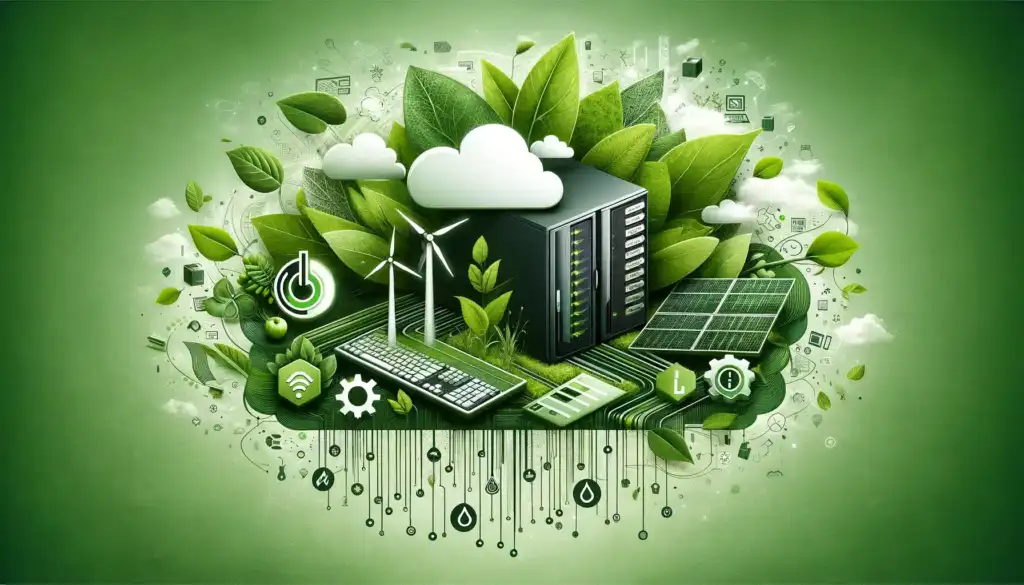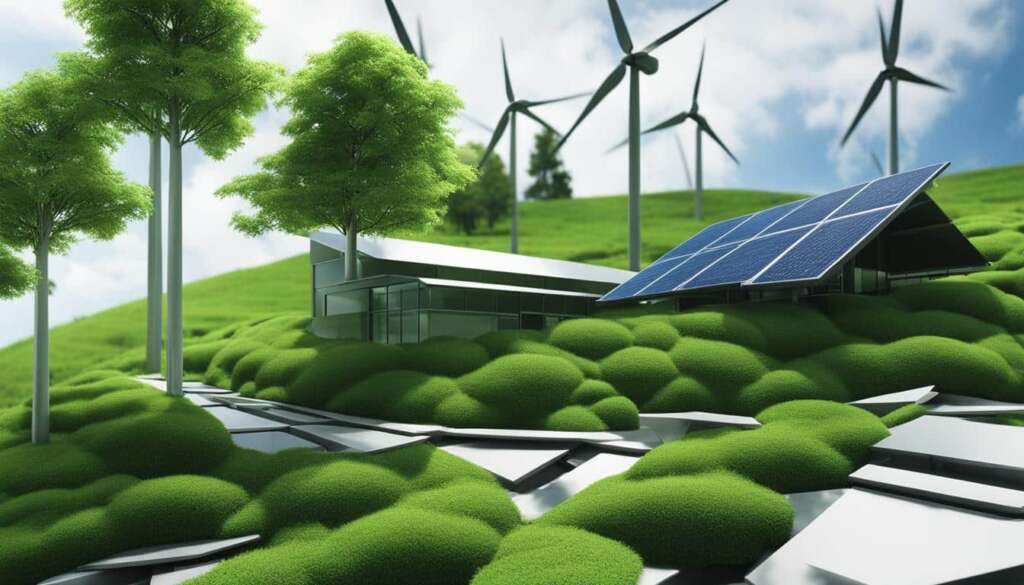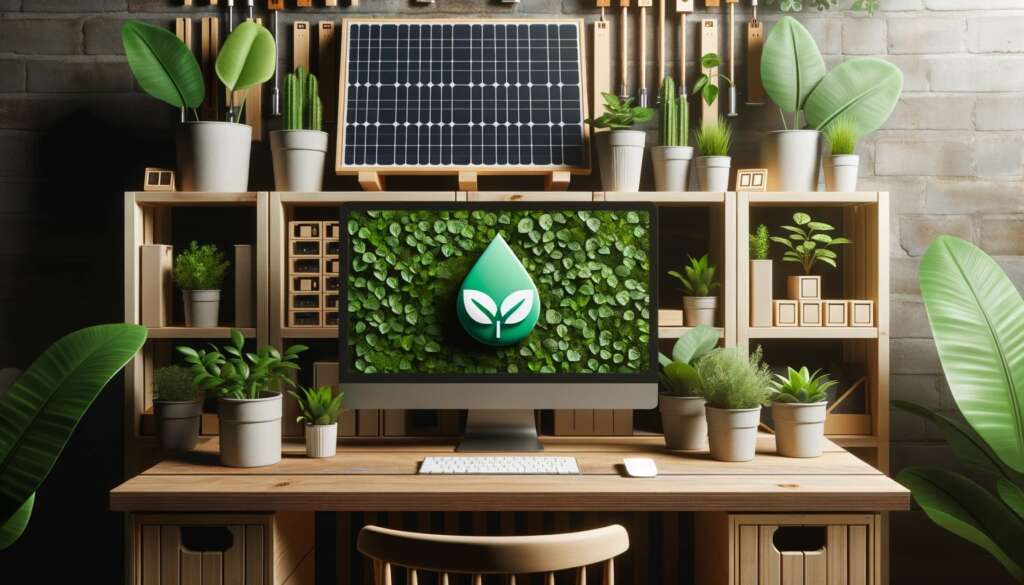Table of Contents
Welcome to our article on green computing and energy efficiency, two vital aspects of sustainable IT. In this informative piece, we will explore the importance of green computing in promoting energy efficiency and sustainability in the IT industry.
But what exactly is green computing? It is a concept that focuses on developing and using computer systems that have minimal environmental impact. The goal is to reduce energy consumption, minimize greenhouse gas emissions, and promote responsible disposal of electronic waste.
Throughout this article, we will delve into various aspects of green computing, from the need for energy efficiency and the rise of sustainable computing to the advancements in renewable energy integration and innovative materials and designs. We will also explore how artificial intelligence can contribute to energy efficiency in computer systems.
By embracing green computing practices, individuals and businesses can play a crucial role in transitioning to a more sustainable future. So, let’s dive into the world of green computing and discover how it can lead us towards a greener and more energy-efficient world.
The Need for Energy Efficiency
Energy efficiency is a critical factor in the tech industry, with significant implications for both the environment and cost savings. Computer devices contribute around 2% of global CO2 emissions, highlighting the urgent need for energy-efficient solutions in the IT sector. By reducing energy consumption, businesses can minimize their environmental impact and play a role in mitigating climate change.
One of the key benefits of energy efficiency is the potential for substantial cost savings. Energy-saving devices consume less electricity, resulting in lower utility bills for individuals and businesses. Additionally, energy-efficient devices often have extended battery life, reducing the need for frequent recharging and further contributing to cost savings. By adopting energy-efficient practices, organizations can make a positive impact on both the planet and their bottom line.
Furthermore, energy efficiency goes beyond reducing greenhouse gas emissions and cost savings. Energy-efficient devices also contribute to the reduction of electronic waste. By designing hardware that requires less energy, manufacturers can help create a more sustainable IT industry that minimizes resource consumption and promotes responsible disposal practices. Investing in energy-efficient technology is a win-win situation, benefiting businesses, the environment, and future generations.
“Energy efficiency is not just about saving money. It’s a vital step towards creating a more sustainable future, where technology functions in harmony with the environment.”
The Environmental Impact of Information and Communication Technologies
Table: Environmental Impact Comparison of Energy-Efficient and Traditional Devices
| Energy-Efficient Devices | Traditional Devices | |
|---|---|---|
| Greenhouse Gas Emissions | Low | High |
| Energy Consumption | Reduced | Higher |
| Cost Savings | Significant | Less |
| Extended Battery Life | Yes | No |
| Electronic Waste Generation | Less | More |
As shown in the table above, energy-efficient devices offer a range of benefits compared to traditional devices. They not only reduce greenhouse gas emissions and energy consumption but also lead to significant cost savings and contribute to a reduction in electronic waste. By prioritizing energy efficiency, the IT industry can make substantial progress towards a more sustainable future.
The Rise of Green Computing
Green computing, also known as sustainable or eco-friendly computing, focuses on developing and using computer systems with minimal environmental impact. It involves designing energy-efficient hardware, optimizing software, and promoting responsible disposal of electronic waste. Green computing is transforming the technology landscape by promoting energy-efficient hardware, implementing power management features, embracing virtualization and cloud computing, and emphasizing recycling and responsible disposal.
One of the key aspects of green computing is the development and adoption of energy-efficient hardware. Manufacturers are investing in research and development to create computer components that operate on lower power levels without compromising performance. This not only reduces energy consumption but also generates less heat, leading to decreased reliance on energy-intensive cooling solutions.
Another important aspect of green computing is the implementation of power management features. Modern computer operating systems and software applications are equipped with features like sleep mode and screen dimming, which help reduce power consumption during periods of inactivity. By automating power management based on user preferences or customizable schedules, energy efficiency is maximized.
Virtualization and cloud computing have also played a significant role in the rise of green computing. By consolidating multiple virtual machines onto a single physical server, energy consumption can be significantly reduced. Additionally, cloud computing eliminates the need for energy-intensive local servers, allowing individuals and businesses to access computing resources remotely.
Benefits of Green Computing:
Energy-Efficient Hardware
Energy-efficient hardware plays a significant role in promoting sustainability and reducing the environmental impact of computer systems. Manufacturers are investing in research and development to create components that optimize performance while reducing energy consumption. These advancements in hardware design allow for the development of devices that consume less power without sacrificing performance.
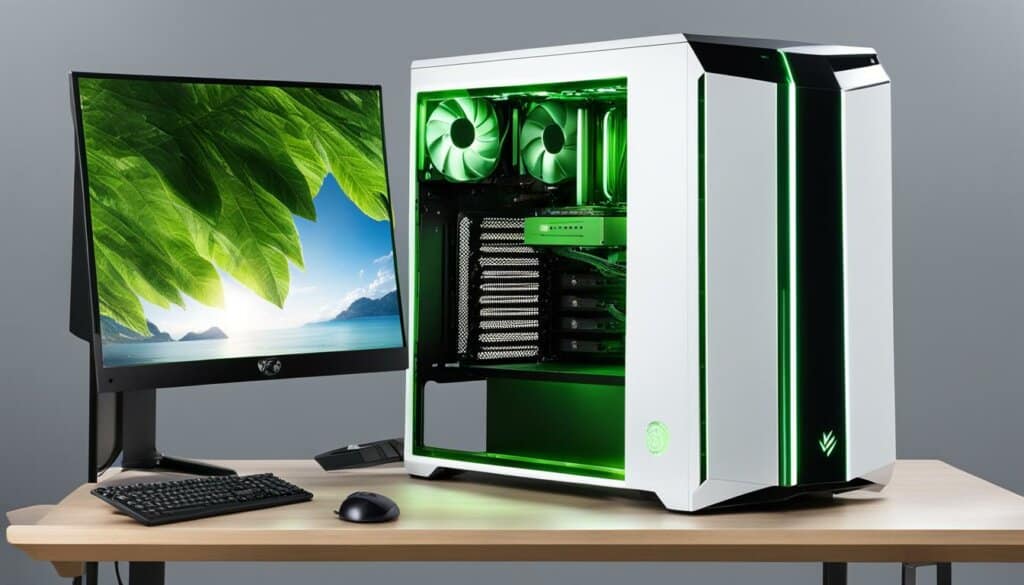
One example of energy-efficient hardware is the development of processors, memory modules, and hard drives that operate on lower power levels. These components are designed to deliver optimized performance while minimizing energy consumption. By reducing the amount of electricity required to power these devices, energy-efficient hardware not only contributes to a greener future but also leads to cost savings for consumers and businesses.
Furthermore, energy-efficient hardware generates less heat, resulting in a decreased need for energy-intensive cooling solutions. This not only saves energy but also contributes to a more sustainable IT infrastructure. By embracing energy-efficient hardware, individuals and organizations can make significant strides in reducing their carbon footprint and promoting a more environmentally friendly approach to computing.
Table: Energy-Efficient Hardware Components
| Component | Features |
|---|---|
| Processors | – Designed to operate on lower power levels – Optimize performance while reducing energy consumption |
| Memory Modules | – Energy-efficient design – Enhanced performance with reduced power consumption |
| Hard Drives | – Low-power operation – Improved storage capacity with reduced energy requirements |
As technology continues to advance, the development of energy-efficient hardware components is crucial in creating a more sustainable and energy-conscious computing environment. By prioritizing devices that optimize performance while reducing energy consumption, we can contribute to a greener future while enjoying the benefits of improved efficiency and cost savings.
Power Management Features
Power management is a crucial aspect of green computing, promoting energy efficiency and reducing unnecessary power consumption. Modern computer operating systems and software applications are equipped with advanced power management features that help optimize energy usage. One of the most commonly used power management features is sleep mode. When a computer or device enters sleep mode, it consumes significantly less power compared to when it is fully active.
Sleep mode is particularly beneficial during periods of inactivity, such as when the user is away from the computer or when the computer is idle. By automatically entering sleep mode after a certain period of inactivity, computers can conserve energy and reduce power consumption. This feature is customizable, allowing users to set their preferred time duration before the computer enters sleep mode.
In addition to sleep mode, power management features also include screen dimming. When a computer is idle, the screen can be automatically dimmed to reduce power consumption. This not only saves energy but also helps extend the lifespan of the display. Furthermore, power management features can be scheduled to align with an individual’s usage patterns, ensuring optimal power usage without compromising productivity.
Benefits of Power Management Features
- Energy Efficiency: Power management features significantly contribute to energy efficiency by reducing power consumption during periods of inactivity.
- Extended Device Lifespan: By minimizing power usage, power management features help prolong the lifespan of computer components, including the display.
- Cost Savings: Conserving energy through power management features can lead to cost savings in electricity bills, especially in organizations with a large number of computers.
- Environmental Impact: Decreased power consumption translates to lower greenhouse gas emissions, contributing to a greener and more sustainable environment.
Overall, power management features play a vital role in promoting energy efficiency and reducing unnecessary power consumption in computer systems. By harnessing the power of power management features, individuals and organizations can contribute towards a more sustainable future.
| Power Management Features | Benefits |
|---|---|
| Sleep mode | – Significant reduction in power consumption during periods of inactivity |
| Screen dimming | – Energy savings and extended display lifespan |
| Customizable schedules | – Optimal power usage aligned with user preferences |
The Rise of Virtualization and Cloud Computing
The evolution of technology has introduced new paradigms in computing that have revolutionized the way we use and manage resources, leading to significant advancements in energy efficiency. Two key trends in this regard are virtualization and cloud computing. These innovations have transformed the IT landscape, enabling businesses to optimize resource utilization, reduce energy consumption, and minimize environmental impact.
Virtualization involves the consolidation of multiple virtual machines onto a single physical server, allowing for more efficient use of computing resources. By minimizing the number of physical servers required, virtualization reduces energy consumption and lowers carbon emissions. Additionally, virtualization enables better scalability and flexibility, allowing businesses to adapt their computing infrastructure to changing needs without the need for excessive hardware upgrades.
Cloud computing, on the other hand, takes virtualization a step further by providing access to computing resources, such as storage and processing power, over the internet. With cloud computing, individuals and businesses can access applications and data remotely, eliminating the need for energy-intensive local servers. This not only reduces energy consumption but also promotes the efficient use of resources, as cloud service providers can dynamically allocate computing power based on demand.
Furthermore, both virtualization and cloud computing contribute to the reduction of electronic waste. By consolidating resources onto fewer physical servers, virtualization reduces the need for hardware, leading to a decrease in electronic waste generation. Similarly, cloud computing eliminates the need for individual users to own and maintain physical hardware, preventing e-waste accumulation in households and businesses. These environmentally friendly approaches align with the principles of green computing and support a more sustainable future.
Recycling and Responsible Disposal
One of the key principles of green computing is the responsible disposal and recycling of electronic waste. With the rapid advancement of technology, electronic devices become obsolete at a faster pace than ever before. This leads to a significant increase in electronic waste, posing environmental and health risks if not handled properly. Recycling and responsible disposal of electronic waste are essential in minimizing the negative impact on the environment and preserving valuable resources for future use.
According to a report by the United Nations, approximately 44.7 million metric tons of electronic waste were generated globally in 2017, with only 20% being recycled through proper channels. Improper disposal methods, such as landfilling or incineration, can release toxic substances into the environment, including heavy metals and hazardous chemicals. These substances can contaminate water sources, soil, and air, endangering both human and animal health.
“Recycling electronic waste is not just about reducing environmental harm; it’s also about recovering valuable resources that can be reused in the manufacturing process. By recycling electronic waste, we can minimize the need for raw materials extraction, conserve energy, and reduce greenhouse gas emissions,” says Dr. Emma Green, an environmental scientist.
Responsible disposal and recycling of electronic waste involve proper collection, dismantling, and processing of discarded devices. This process ensures that valuable materials, such as metals and plastics, are recovered and used in the production of new devices. Governments and organizations around the world are implementing regulations and initiatives to promote e-waste recycling and raise awareness about the importance of responsible disposal.
To encourage individuals and businesses to participate in electronic waste recycling, many countries have implemented e-waste collection programs and established dedicated recycling centers. These centers ensure that electronic devices are properly disassembled, and their components are recycled or disposed of in an environmentally friendly manner. Some manufacturers also provide take-back programs where customers can return their old devices for recycling when purchasing new ones. These initiatives aim to make electronic waste recycling more accessible and convenient for everyone.
| Benefits of Responsible Disposal and Recycling | Electronic Waste Facts |
|---|---|
|
|
Advancements in Renewable Energy Integration
The rise of green computing has paved the way for exciting developments in renewable energy integration within the IT industry. By harnessing the power of renewable energy sources such as solar and wind, computer devices can significantly reduce their carbon footprint and contribute to a more sustainable future.
Renewable energy integration in green computing not only benefits the environment but also promotes energy efficiency and cost savings. By utilizing clean energy sources, computer hardware can operate with lower environmental impact and reduced reliance on fossil fuels. This transition to renewable energy also helps to mitigate climate change by decreasing greenhouse gas emissions.
“Integrating renewable energy sources into green computing is a crucial step towards achieving a more sustainable and energy-efficient IT industry,” says Dr. Emma Collins, an environmental scientist. “By shifting our reliance to renewable energy, we can significantly reduce carbon emissions and create a more resilient and environmentally-friendly computing infrastructure.”
A comprehensive table illustrating the impact of renewable energy integration on computer hardware’s carbon footprint is provided below:
| Renewable Energy Integration | Carbon Footprint Reduction |
|---|---|
| Solar Power Integration | Up to 50% reduction in carbon emissions |
| Wind Power Integration | Up to 60% reduction in carbon emissions |
| Hydropower Integration | Up to 70% reduction in carbon emissions |
This table demonstrates the significant carbon footprint reduction achievable through the integration of renewable energy sources. By incorporating solar power, wind power, or hydropower into computer systems, organizations can take substantial steps towards sustainability and contribute to a greener computing infrastructure.
Benefits of Renewable Energy Integration in Green Computing
- Reduced carbon emissions: Renewable energy integration helps reduce the carbon footprint of computing systems, mitigating climate change and its environmental impacts.
- Energy efficiency: Clean energy sources enable more efficient operation of computer hardware, optimizing energy consumption and minimizing waste.
- Cost savings: Utilizing renewable energy reduces reliance on traditional energy sources, resulting in long-term cost savings for businesses and individuals.
- Sustainable future: By transitioning to renewable energy, the IT industry can contribute to a more sustainable future and promote eco-friendly practices.
Renewable energy integration is a crucial aspect of green computing, providing the IT industry with an opportunity to reduce its environmental impact and create a more sustainable future. By embracing this advancement, we can pave the way for a greener and more energy-efficient world.
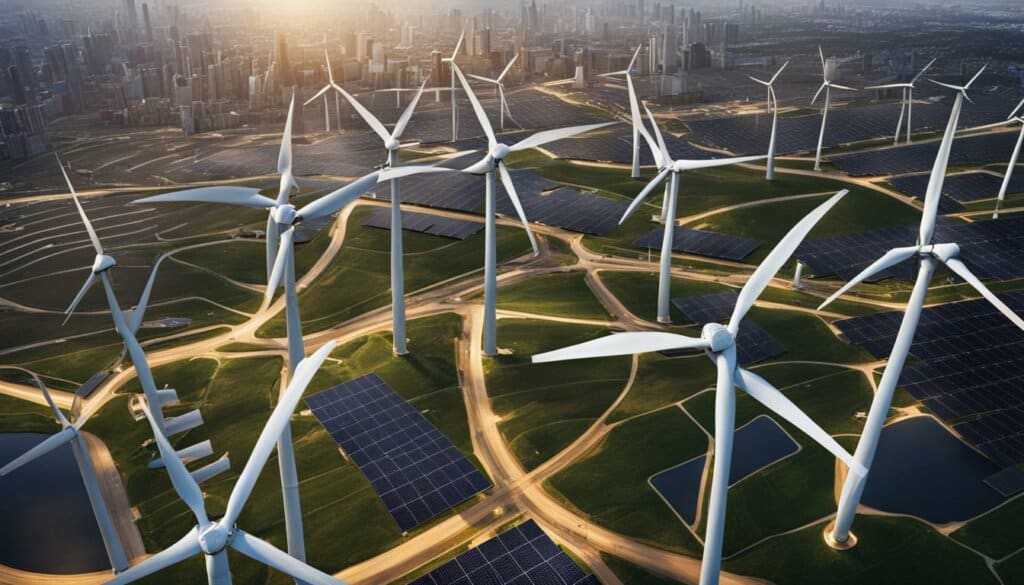
Innovative Materials and Designs
The development of innovative materials and designs is playing a crucial role in the pursuit of energy efficiency and sustainable devices in the field of green computing. Researchers and manufacturers are exploring new materials that offer improved performance while minimizing energy consumption. These innovative materials are being used to create energy-efficient hardware components such as processors, memory modules, and hard drives.
One example of innovative material is graphene, a single layer of carbon atoms arranged in a two-dimensional honeycomb lattice. Graphene has exceptional electrical and thermal conductivity properties, making it an ideal material for creating energy-efficient processors. Its unique structure allows for faster electrical signals and reduced power consumption, leading to more sustainable computing devices.
Another area of focus is sustainable designs that optimize energy consumption without compromising performance. Designers are exploring ways to minimize the energy required for cooling systems by using improved heat dissipation techniques. By incorporating efficient ventilation and cooling mechanisms, devices can operate at lower temperatures, reducing the need for energy-intensive cooling solutions.
Innovative Materials and Designs: Examples
| Material/Design | Advantages |
|---|---|
| Graphene-based processors | Improved electrical and thermal conductivity, reduced power consumption |
| Eco-friendly cooling systems | Reduced energy consumption for cooling, improved heat dissipation |
| Bio-based materials | Renewable and biodegradable, reduced environmental impact |
| Energy-efficient display technologies | Reduced power consumption, improved visual quality |
These innovative materials and designs are promising steps towards creating more sustainable computing devices. By incorporating them into the development of hardware and optimizing energy consumption, the IT industry can make significant strides in reducing energy consumption and minimizing its environmental impact.
The Power of Artificial Intelligence in Energy Efficiency
Artificial intelligence (AI) is revolutionizing the world of green computing, offering unprecedented opportunities for energy efficiency and power consumption optimization. By leveraging AI algorithms and machine learning techniques, computer systems can dynamically adapt and optimize their performance to minimize energy usage without compromising functionality.
One of the key applications of AI in energy efficiency is in power management. AI algorithms can analyze data on user behavior, system workload, and environmental conditions to make real-time adjustments that maximize energy savings. For example, AI can automatically adjust the brightness of displays based on ambient lighting, put idle processes into low-power states, or optimize the allocation of resources to reduce overall power consumption.
“AI-driven power management features enable computer systems to intelligently adapt their energy usage, leading to significant energy savings and increased overall efficiency.”
Smart Grid Optimization
In addition to power management, AI also plays a vital role in optimizing energy usage in broader contexts, such as smart grid systems. By analyzing data from sensors, weather forecasts, and energy consumption patterns, AI algorithms can optimize the distribution and allocation of energy resources in the grid. This results in more efficient and reliable energy delivery, reducing waste and supporting the integration of renewable energy sources.
Furthermore, AI can assist in identifying energy-intensive processes or devices and suggest energy-saving alternatives. This proactive approach allows users to make informed decisions and take actions that promote energy efficiency at both the individual and organizational levels.
| Benefit | Description |
|---|---|
| Optimized Power Consumption | AI algorithms dynamically adjust power usage to minimize energy consumption. |
| Proactive Energy Efficiency | AI identifies energy-intensive processes and suggests energy-saving alternatives. |
| Smart Grid Optimization | AI optimizes energy distribution and allocation in smart grid systems. |
By harnessing the power of AI, we can unlock significant energy-saving potential and pave the way for a more sustainable future. From intelligent power management to smart grid optimization, AI-driven solutions contribute to reducing our carbon footprint, promoting energy efficiency, and creating a greener world.
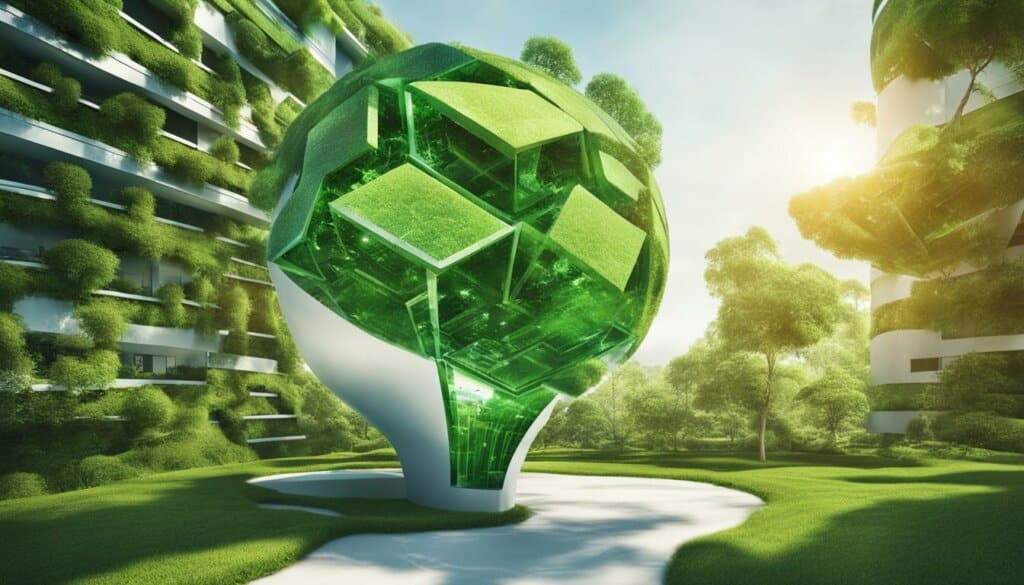
Embracing Green Computing
As the importance of sustainability continues to grow, embracing green computing practices has become crucial for individuals and businesses alike. By prioritizing energy efficiency and minimizing environmental impact, we can pave the way for a greener future. Green computing offers a range of strategies and solutions to reduce energy consumption and promote sustainability in the IT industry.
One way to embrace green computing is by adopting energy-efficient devices. By choosing laptops, desktops, and servers that are designed with energy-saving features, we can significantly reduce our energy consumption. These devices consume less electricity, leading to cost savings and a smaller carbon footprint. Investing in energy-efficient hardware is a tangible step towards a more sustainable computing environment.
“Green computing is not just about using energy-efficient devices; it’s a holistic approach that encompasses optimizing software, embracing virtualization and cloud computing, and promoting responsible disposal of electronic waste.”
Implementing power management features
Another important aspect of green computing is the implementation of power management features. Modern operating systems and software applications come equipped with built-in tools that allow users to optimize power settings. Features such as sleep mode and screen dimming can significantly reduce power consumption during periods of inactivity. By taking advantage of these features and customizing power management settings, we can maximize energy efficiency and minimize wasteful energy consumption.
Embracing green computing also involves supporting companies that prioritize sustainability. By choosing to do business with organizations that are committed to environmental responsibility, we can contribute to the overall goal of reducing energy consumption and promoting sustainable practices in the IT industry. Additionally, investing in electronic waste recycling initiatives helps to minimize the environmental impact of our technology consumption and promotes the responsible disposal of electronic waste.
| Benefits of Embracing Green Computing | Actions to Take |
|---|---|
| Reduced energy consumption and cost savings | Adopt energy-efficient devices and implement power management features |
| Minimized environmental impact | Support companies that prioritize sustainability and invest in electronic waste recycling initiatives |
| Promotion of a greener future | Advocate for green computing practices and spread awareness |
Embracing green computing is not just a responsibility, but also an opportunity to make a positive impact on our environment. By making conscious choices and taking proactive measures, we can contribute to a more sustainable and energy-efficient future. As technology continues to advance, it is crucial that we prioritize green computing practices to ensure that our digital footprint aligns with our environmental goals.
Conclusion
Green computing is an essential aspect of the energy-efficiency revolution in the tech industry. It focuses on the development and utilization of computer systems that have minimal environmental impact. By embracing the principles of green computing, individuals, businesses, and society as a whole can contribute to a sustainable future by reducing energy consumption and minimizing environmental harm.
It is imperative to prioritize energy efficiency and promote the development of eco-friendly technology. Investing in energy-efficient devices, supporting companies that prioritize sustainability, and participating in electronic waste recycling initiatives are all crucial steps towards a greener and more sustainable world.
By adopting green computing practices, we can work towards a future where technology coexists harmoniously with the environment. This involves optimizing energy consumption, minimizing greenhouse gas emissions, and responsibly disposing of electronic waste. Together, we can create a sustainable future powered by green computing.
FAQ
What is green computing?
Green computing focuses on developing and using computer systems with minimal environmental impact. It aims to reduce energy consumption, minimize greenhouse gas emissions, and promote responsible disposal of electronic waste.
Why is energy efficiency important in the tech industry?
Energy efficiency is crucial in the tech industry because it helps minimize greenhouse gas emissions, leads to cost savings, extends battery life, and contributes to reduced electronic waste.
What does green computing involve?
Green computing involves designing energy-efficient hardware, optimizing software, and promoting responsible disposal of electronic waste.
How does energy-efficient hardware reduce energy consumption?
Energy-efficient hardware components, such as processors and memory modules, are designed to operate on lower power levels without compromising performance. They also generate less heat, requiring less energy-intensive cooling solutions.
What are power management features?
Power management features are built into modern computer operating systems and software applications. They include features like sleep mode and screen dimming, which help reduce power consumption during periods of inactivity.
How does virtualization and cloud computing help reduce energy consumption?
Virtualization allows multiple virtual machines to be consolidated onto a single physical server, reducing energy consumption. Cloud computing eliminates the need for energy-intensive local servers by allowing individuals and businesses to access computing resources remotely.
Why is responsible disposal and recycling of electronic waste important?
Responsible disposal and recycling of electronic waste minimize environmental harm and ensure the recovery of valuable materials, such as metals, for reuse in the manufacturing of new devices.
How does renewable energy integration contribute to green computing?
Integrating renewable energy sources, such as solar and wind power, to run computer devices further reduces the carbon footprint of hardware and promotes a more sustainable energy source.
What role do innovative materials and designs play in green computing?
Innovative materials and designs optimize energy consumption, improve performance, and enable the production of more sustainable computer hardware.
How does artificial intelligence contribute to energy efficiency?
Artificial intelligence algorithms can dynamically optimize power consumption, load balancing, and resource allocation, resulting in greater energy savings and efficiency in computer systems.
Why is embracing green computing important?
Embracing green computing practices is essential for transitioning to a more sustainable future, reducing energy consumption, and minimizing environmental harm.

